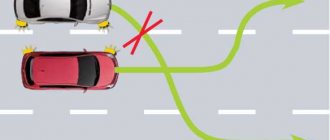To the list of useful itemsAll news
Category: Summer Tire Tests
49023 views49023
Winter has arrived and with the first serious cold, a massive re-shoeing of tires or the purchase of winter tires begins. But such an event cannot be called a whim of car owners. Changing tires is a procedure regulated by law. The nuances of exactly how to carry out such work are described in regulatory documents. The law that regulates all this is called “Technical Regulations of the Customs Union TR CU 018/2011 “On the safety of wheeled vehicles.”
When to change your shoes for the summer?
Tires need to be changed to summer ones in Russia in June 2021.
This is what current legislation says, and only if you have studded tires. And even this is relative - we will find out why below. And this issue is not regulated by traffic rules, as many believe. The rules for the use of tires on wheels are regulated by Section 5 of the Basic Provisions (Appendix to the Traffic Regulations), and not a word is said here about the seasonality of the use of rubber.
The prescription of the seasons when it is necessary to install winter tires, and when to install summer tires, is contained in the Technical Regulations - this is today a variation of GOST on the technical equipment of modern cars. But there is not a word in it about the date when you need to switch to summer tires according to the law. It only talks about prohibitions on using winter tires in certain seasons and only with studs:
5.5. It is prohibited to operate vehicles equipped with tires with anti-skid studs in the summer (June, July, August).
Thus, the legal acts of 2021 do not establish a rule at all when to install summer tires after winter. Only one of them stipulates that you cannot drive in the “winter” during the 3 summer months – from June to August inclusive.
But there is an important subtlety!
It consists in the fact that the same Technical Regulations contain a note indicating that in each city it is possible to change such a ban, but only upward:
The terms of the operation ban may be changed upward by regional government bodies of the member states of the Customs Union.
Regional bodies are regions, subjects of Russia. You can find out whether such changes have been made specifically in your region from the official websites of road services or the traffic police of your city. But, as a rule, their appearance is widely covered in the local press.
One thing we can say for sure is that in March, April and May of this year there are none in the largest cities.
- In Moscow, there is a general rule for the Russian Federation - you can legally switch to summer tires in June 2021.
- In St. Petersburg, the ban period was also not changed, and here it operates according to the general rules of the Technical Regulations.
- Even in the warm Crimea and Sochi (as well as throughout the Krasnodar Territory) the period has not been increased.
You will also be interested in:
- Is there a fine for driving on summer tires in winter and winter tires in summer today? What date will it start?
- Is it possible to drive on winter tires in summer and what is the fine?
- In winter on summer tires: what are the requirements and the penalty?
Is it possible to drive on all-season tires in winter in 2021 according to the new rules?
When signs of winter, in particular snow and ice, become more common on the streets, only then vehicle owners begin to take care of their cars, and this needs to be done much earlier.
The time when it is necessary to install winter tires on a car is now prescribed by law, although this does not mean that driving on tires that are inappropriate for the season will be punishable by a fine.
You can find out more about this law and about the enforcement measures that are applied to unscrupulous drivers from us. As for specific prohibitions, driving a car with installed studded tires (winter type) is prohibited in the summer months, the same applies to regular, all-season tires, but in the winter months.
Law on changing tires to “summer” from March 2021
However, a number of media outlets are disseminating incorrect information about the obligation to switch to summer tires as early as March 2021, citing local legislation as the reason for this rule.
But, as we mentioned above, no local laws have been adopted. You can check this, for example, by requesting an official comment through the traffic police online reception and selecting your city (region) in the address field.
And since April?
And in this case, too, there is no new law that would oblige one to change tires to summer ones in April of this year. The procedure for setting “winter” to “summer” today is regulated only by the consciousness of citizens, since driving on studs in wet weather is more dangerous than driving on summer tires.
Moreover, according to the law, there is no need to change tires in May 2021. As we have already commented above, only from June it is forbidden to ride on studded wheels.
Are Velcro considered winter tires by law?
All-season tires can only be used if they are marked with the appropriate marking: M+S; M&S; MS and a three-headed mountain with a snowflake inside.
Results:
- By law, you can change your tires to winter ones from September to November;
- In practice, you need to choose a specific date, taking into account the specific weather conditions of the region, but it is not recommended to do this later than November 15 - the unofficial date for replacing summer tires;
- There is no penalty for using a summer or all-season tire in winter (December, January, February).
Fine
It’s no joke, but as of 2021 there is no punishment for violating clause 5.5 of the Technical Regulations, just as there are no fines, no deprivation of rights, or other types of punishment for any non-compliance with this regulatory act. The current Code of Administrative Offenses simply does not provide for such.
The only fine in the amount of 500 rubles or even a warning can be issued for violations of the operating conditions of vehicles according to traffic rules under Part 1 of Article 12.5 of the Administrative Code. But these two regulatory documents should not be confused - the obligation to change shoes is not stated anywhere, and driving on spikes in the summer is in the regulations; in the Rules there was not a word about the seasonality of using rubber.
You can check the current version of all traffic police fines yourself by searching, and you will not find here a single sanction that would be applied for violations of regulations, as well as GOSTs, in force in Russia.
Expert opinion
Yuri Panchenko
Driving instructor, human rights activist, author of books. 10 years of experience.
The Technical Regulations of the Customs Union on the safety of wheeled vehicles contain all the requirements for all vehicles that are produced and operated on the roads of the Russian Federation.
Unfortunately, since its adoption, the corresponding amendments to the traffic rules have not been adopted. The result is a legal conflict: on the one hand, malfunctions for which operation is prohibited are listed in the Basic Regulations for Permission to Operation, and no one has been looking into this list for years. On the other hand, a similar, but more complete list is contained in the technical regulations.
Today, alas, the operation of a car is punishable only with those faults that are given in the Basic Provisions for Admission. Therefore, there is no penalty for driving a car with winter wheels in the summer and with summer wheels in the winter, and, apparently, it will not appear soon. And therefore, drivers continue to drive on the roads, risking not only their lives, but also the lives of those around them.
Ask a Question
Normative base
Legal regulation in the field of installation and use of tires on vehicles in the summer is carried out by the following legislative acts:
- Technical regulations TR CU 018/2011 – regarding the timing of replacement of winter tires.
- Appendix 1 to Government Decree No. 1008 of December 5, 2011 - on what criteria tires must meet in order for the car owner to successfully pass inspection.
- Section 5 of the “List of faults and conditions under which the operation of the vehicle is prohibited”, contained in Government Decree No. 1090 of October 23, 1993, states that if the tires do not meet which parameters, the operation of the vehicle is prohibited.
- Chapter 12 of the Code of Administrative Offenses – on liability for non-compliance with the legislation on the use of tires.
But there are requirements for any type of rubber
And they are already stated directly and clearly in the Rules of the Road, specifically in the List of conditions under which the operation of a car is prohibited. This application has a whole section containing a list of faults that prevent you from driving your car on public roads.
Wear
For summer and winter tires, different levels of possible wear apply, at which you cannot drive.
For “summer” you can’t drive on tires with the following tread depth:
- less than 0.8 mm for motorcycles, scooters and mopeds,
- less than 1 mm for trucks over 3.5 tons and trailers for them,
- less than 1.6 mm for passenger cars and trucks less than 3.5 tons and trailers for them,
- less than 2 mm for all types of buses (with more than 8 seats).
But for winter there is no division into categories of cars - the permissible wear for them is the same - at least 4 mm, and here it no longer matters whether you have spikes. Therefore, if the wear of winter tires is less than 4 mm, then they need to be replaced with summer tires, unless, of course, your summer tires comply with traffic regulations for wear.
Damage
It is also prohibited to drive a vehicle whose tires have operational defects, including the following:
- torn damage and cuts (including side ones), if the rubber cord is visible,
- peeling in the tread area,
- peeling on the side,
- punctured tires.
Different tires
You cannot ride on wheels in the following cases, when the tires on them are different on the same axle (one at the front or rear on the left, another on the right):
- by size (radius, profile width and height),
- by design (radial and diagonal),
- one with a camera, the other - tubeless,
- different models,
- along the tread.
It is also important to know that it is prohibited to use wheels with different tires based on the presence of studs: if all are studless and at least one with studs, and vice versa.
Does not match the vehicle
And the last prohibition is if the tires do not match the car in terms of load or size.
How will the inspector determine the wheel size? Everything is very simple. If, for example, you install 16-radius wheels on a Lada Granta, the inspector may issue a fine under Part 1 of Article 12.5 of the Code of Administrative Offenses of 500 rubles, since the design of the model does not provide for such tire sizes.
Same with the load. The table for the correspondence of the load index to the vehicle weight is contained in Table 5.2 of the regulations.
Thus, if you have winter tires, at least one of the parameters of which does not comply with traffic regulations, then you need to switch to summer tires by law, if the latter is new enough and the same enough to satisfy all the above conditions. Otherwise, the only thing left to do is buy new tires.
Are all-season tires allowed in winter?
With the onset of winter cold, most car owners in our country replace summer tires with winter or all-season tires, since in severe winter conditions it is unsafe to drive on summer tires.
At the same time, many drivers are interested in the question of whether it is possible to drive on all-season tires in the cold season. Manufacturers often impose restrictions on their all-season tires and recommend using them only at a certain ambient temperature. In addition, such tires are especially effective in the off-season, and during the summer and winter periods these varieties are not suitable for everyone.
Each driver has the right to independently choose which tires to install on his car. However, to prevent the unpleasant consequences of incorrectly selected tires, it is necessary to install for each season those options that are not prohibited by law.
Many car enthusiasts prefer to save money
Existing fines for improper use of car tires in 2020
In 2020, Chapter 12 of the Code of Administrative Offenses, which regulates the liability of motorists for violating traffic rules, does not contain any indication of sanctions for non-compliance with the requirements of the Technical Regulations TR CU 018/2011.
And since only it contains a mention of the timing of tire replacement, fines for late replacement of winter tires with summer tires in 2021 cannot currently be imposed.
And yet, traffic police officers have the opportunity to punish the driver with a monetary penalty. But only for non-compliance of tires with the requirements specified in Section 5 of the “List of Malfunctions and Conditions” to the Traffic Regulations. In this case, sanctions will apply under Part 1 of Art. 12.5. Administrative Code:
- warning;
- or a fine of 500 rubles.
For example, the above liability should be expected if the tire:
- has a tread height below the established values;
- has punctures, cuts, and delaminations of the frame;
- does not correspond to the speed index and weight of the vehicle model.
In addition, a warning or 500 rubles will be issued if different tires are installed on one axle of the vehicle (front or rear) on the left and right. For example, the front left has summer tires, and the front right has winter tires. Or one tire is new and the other is retreaded.
The traffic police will also fine you for installing both studded and non-studded tires on a vehicle at the same time (regardless of the axle). For example, 3 wheels have tires without studs, and the remaining one has them.
So it turns out that if you drive in the summer on the same studded tires, then there is no penalty. And if, for example, you put tires with studs, but of different sizes, on one axle in the hot season, then the driver will face sanctions under Part 1 of Art. 12.5. Code of Administrative Offences.
If the spare tire is different from those already installed on the vehicle
Each car has a spare tire, which will be needed in case one of the tires has been punctured and you need to get to the nearest tire shop without resorting to a tow truck.
In clause 5.7.4. Technical regulations TR CU 018/2011 say that different tires (winter and non-winter, for example) cannot be installed on the same axle. However, the requirements of this paragraph do not apply in the case of temporary installation of a spare wheel on the vehicle.
In this case, it is important whether the “spare tire” is on winter tires or summer tires (since the note to clause 5.7.4. applies only to this clause). That is, “seasonality” must correspond. For example, you cannot install a spare tire in the summer if it (theoretically) has anti-skid studs (but there will be no fine for this).
In clause 5.5. “The list of faults and conditions”, which contains a similar rule about the inadmissibility of installing different tires on one axle, there is no such note about the “spare wheel” as in the Technical Regulations TR CU 018/2011. Therefore, it remains unclear whether or not the driver will be able to be charged under Part 1 of Art. 12.5. Code of Administrative Offenses specifically for the temporary use of a spare wheel that is different in size or other characteristics from those already installed on the vehicle (for the out-of-season “spare wheel,” as we have already indicated, there are no fines).











